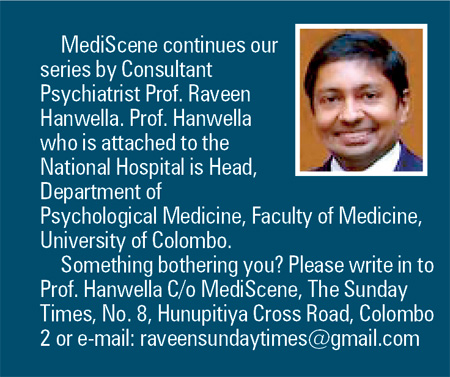Normal is very much worth saving
Due to the heavy rain, it was a slack morning in the NHSL psychiatry clinic when my cell phone rang. It was Professor Carlo Fonseka, my former physiology teacher. I always enjoy a chat with my old teacher. Now in his eighties, his mind is still razor sharp.

Unwarranted fears of a specific situation:Fear of flying
He was concerned about a television programme he had seen about factors leading to an epidemic of mental health problems, drug addiction and sexual misbehaviour in the younger members of our population. I also remember the time when it was widely reported that one in five Sri Lankans has a mental illness. What is the truth?
The theme of my article is taken from a book by Dr. Allen Frances. The complete title of the book is Saving Normal: An Insider’s Revolt Against Out-Of-Control Psychiatric Diagnosis, DSM-5, Big Pharma, And The Medicalization of Ordinary Life. Dr. Frances is professor emeritus and former chair of psychiatry at Duke University and also chair of the DSM-4 Task Force (DSM stands for Diagnostic and Statistical Manual, the big book that attempts to classify all mental illnesses). What was the concern of Dr. Frances? Before I answer the question, I would need to educate the reader on basic epidemiology. Nothing too heavy, I assure you.
In medicine we are taught that a patient’s complaints are symptoms and what the doctor elicits are signs. The symptoms constitute the patient’s illness and the signs the disease. For example, a person may complain of shortness of breath and the doctor on examination of the person’s lungs finds there are rhonchi and diagnoses the person as having bronchial asthma. The difficulty in breathing is the illness and the disease, bronchial asthma.
Sometimes the patient may not have any complaints but the doctor would find signs of disease. This is common in diabetes where the patient often has no complaints but the blood sugar on routine testing is high. The reverse may also happen where the patient has complaints but the doctor cannot find a cause. Therefore, one may have illness without disease and disease without illness. A good doctor should address both illness and disease in his practice.
 The second important point is that the borderline between disease and non-disease is not sharply defined. A Professor of Medicine George Pickering advanced the then revolutionary proposal that the idea of a sharp distinction between health and disease is a medical artefact. Writing to the Lancet he pointed out that blood pressure in humans follows a normal distribution with ‘low’ merging imperceptibly into ‘high.’ The normal distribution is inherent in nature and found in many biological measurements. For example, if you take the height of people some are abnormally short or unusually tall with the majority being of average height. If plotted on a graph it looks like a symmetrical mountain. It was Pickering’s contention that human disease, in most instances, follows this normal distribution and where the doctor draws the cut-off determines the difference between disease and non-disease.
The second important point is that the borderline between disease and non-disease is not sharply defined. A Professor of Medicine George Pickering advanced the then revolutionary proposal that the idea of a sharp distinction between health and disease is a medical artefact. Writing to the Lancet he pointed out that blood pressure in humans follows a normal distribution with ‘low’ merging imperceptibly into ‘high.’ The normal distribution is inherent in nature and found in many biological measurements. For example, if you take the height of people some are abnormally short or unusually tall with the majority being of average height. If plotted on a graph it looks like a symmetrical mountain. It was Pickering’s contention that human disease, in most instances, follows this normal distribution and where the doctor draws the cut-off determines the difference between disease and non-disease.
To quote Pickering on the subject of high blood pressure of unknown cause or essential hypertension, “Essential hypertension is a type of disease not hitherto recognised in medicine in which the defect is quantitative not qualitative. It is difficult for doctors to understand because it is a departure from the ordinary process of binary thought to which they are brought up. Medicine in its present state can count up to two but not beyond.”
More than half a century after Pickering, many doctors have not grasped the fact that in addition to hypertension, disease is nearly always a quantitative rather than a categorical or qualitative phenomenon. What Pickering showed to be true of hypertension is the norm rather than the exception. This is especially true of psychiatry. In psychiatry, the exact cause of most disorders is unknown. Diagnosis is based on a set of symptoms or signs characteristic of that condition.
For example, in the condition called specific phobia patients have unwarranted fears of specific objects, or situations. The commonest fears are for animals, blood, heights, travel by plane, being closed in, and thunderstorms. Most of us are a little nervous in at least one of the situations mentioned. Does that mean all of us have a psychiatric illness? It all depends on where you draw the line. In specific phobias it would be necessary for the fear to seriously impair a person’s day-to-day functioning to constitute a psychiatric disorder and need treatment.
It would also depend on the person’s vocation. For example, a person who is afraid of blood may function fine in day-to-day life but if he were to become a medical student would need treatment.
Is it necessary to categorise at all? Yes, it is. The fact that disease exists in a continuum does not mean that disease does not exist. If you deny this, it is the fallacy of the beard. At what point would you say that persons have beards? Is it when they have a thousand hairs, or hundred thousand overgrown hairs on their chin? Though it is a continuum no one would deny that in the world there are definitely those with beards and those without beards. Diagnosis is most difficult in the borderland between normality and abnormality. Definitive diagnosis is necessary to determine optimum treatment and research but there should be a balancing of the risks and benefits of over-diagnosis versus under-diagnosis.
To return to Dr. Allen Frances, what was he so concerned about? He was concerned that DSM 5 has gone beyond its mandate and medicalised normal human problems and emotions. For example the forgetting of names and faces that come with age would be covered by DSM5 ‘minor neurocognitive disorder’, normal worries of life under ‘mixed anxiety/depressive disorder’, grief of losing a loved one ‘depressive disorder’ and the temper tantrums of young children ‘temper dysregulation disorder.’
I end by quoting Dr Frances. ‘…we are not a bunch of sick individuals, each of us having a bunch of psychiatric diagnoses, cumulatively constituting a sick society. Most of us are normal enough and would like to stay that way. The legacy of Hippocrates rings true today as it did 2500 years ago – be modest, know your limitations, and first do no harm. Normal is very much worth saving. And so is psychiatry.’


